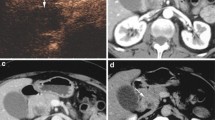Abstract
Purpose
The aim of this study was to evaluate the enhancement behavior of pancreatic ductal carcinoma by contrast-enhanced sonography with agent detection imaging (ADI), and to clarify the origin of microbubble signals by comparisons with histological findings of resected specimens.
Methods
The subjects were 21 patients with resectable pancreatic carcinoma. The final histological diagnosis was tubular adenocarcinoma in 20 cases, and anaplastic carcinoma in one case. Ultrasound examinations were performed using an Acuson Sequoia 512 series system, and the contrast agent (Levovist) was injected intravenously in doses of 7 ml (300 mg/ml). The ADI signals (in the tumor) were recorded continuously for 30 s after an injection of Levovist (vascular image) and then obtained intermittently (30 s time-intervals) until the signal had diminished in pancreatic tissue (perfusion image).
Results
Contrast enhancement of the tumor was observed in 71.4% of subjects on the vascular image and 76.3% of subjects on the perfusion image. Enhancement patterns on the vascular image were classified into three types: VI-1 (linear enhancement), VI-2 (spotty enhancement), and VI-3 (no enhancement). VI-1, VI-2, and VI-3 were seen in 9 (42.8%), 6 (28.6%), and 6 (28.6%) of the 21 cases, respectively. Enhancement patterns on the perfusion image were classified into four types: PI-1 (diffuse uneven enhancement), PI-2 (spotty enhancement), PI-3 (peripheral enhancement), and PI-4 (negative enhancement). The incidence of PI-1, PI-2, PI-3, and PI-4 was 4.8%, 42.9%, 28.6%, and 23.8%, respectively. With respect to resectable cases, these enhancement patterns were compared with histological findings, i.e., the distribution of blood vessels in the tumor, remaining pancreatic tissues in the tumor, differentiation of types of adenocarcinoma, volume of stroma, and invasion types of carcinoma. The enhanced patterns consequently corresponded to either the distribution of the blood vessels or the remaining pancreatic tissues in the tumor.
Conclusion
This study indicated that pancreatic ductal carcinoma is frequently enhanced by microbubbles, and the signals seem to originate from fine blood vessels and the remaining pancreatic tissues in the tumor.
Similar content being viewed by others
References
K Hara K Numata K Tanaka et al. (2001) ArticleTitleDiagnosis of advanced hepatocellular carcinoma using contrast-enhanced harmonic gray-scale imaging with enhancement agents (Levovist): correlation with helical CT and US angiography J Med Ultrason 28 127–33
T Hirai H Ohishi E Tokuno et al. (2002) ArticleTitleQualitative diagnosis of hepatocellular carcinoma by contrast enhanced ultrasonography using coded harmonic Angio with Levovist J Med Ultrason 29 3–9
YL Wen M Kudo Y Minami et al. (2003) ArticleTitleDetection of tumor vascularity in hepatocellular carcinoma with contrast-enhanced dynamic flow imaging: comparison with contrast-enhanced power Doppler imaging J Med Ultrason 30 141–51
Y Matsuda I Yabuuchi T Ito et al. (2004) ArticleTitleClassification of ultrasonographic images of small hepatocellular carcinoma using galactose-based contrast agent: relation between image patterns and histologic features J Med Ultrason 31 111–20
O Oshikawa S Tanaka T Ioka et al. (2002) ArticleTitleDynamic sonography of pancreatic tumors: comparison with dynamic CT AJR Am J Roentgenol 178 1133–7 Occurrence Handle11959716
K Takeda H Goto Y Hirooka et al. (2003) ArticleTitleContrast-enhanced transabdominal ultrasonography in the diagnosis of pancreatic mass lesions Acta Radiol 44 103–6 Occurrence Handle10.1034/j.1600-0455.2003.00009.x Occurrence Handle1:STN:280:DC%2BD3s7hslynug%3D%3D Occurrence Handle12631008
M Kitano M Kudo K Maekawa et al. (2004) ArticleTitleDynamic imaging of pancreatic diseases by contrast enhanced coded phase inversion harmonic ultrasonography Gut 53 854–9 Occurrence Handle10.1136/gut.2003.029934 Occurrence Handle1:STN:280:DC%2BD2c3jvFyjtQ%3D%3D Occurrence Handle15138213
T Ohshima T Yamaguchi T Ishihara et al. (2004) ArticleTitleEvaluation of blood flow in pancreatic ductal carcinoma using contrast-enhanced, wide-band Doppler ultrasonography: correlation with tumor characteristics and vascular endothelial growth factor Pancreas 28 335–43 Occurrence Handle15084983
H Ding M Kudo H Onda et al. (2001) ArticleTitleSonographic diagnosis of pancreatic islet cell tumor: value of intermittent harmonic image J Clinical Ultrasound 27 411–6
N Ichino Y Horiguchi H Imai et al. (2004) ArticleTitleContrast enhanced ultrasonography of invasive pancreatic carcinoma Jpn J Med Ultrason 31 IssueIDSuppl 196
General rules for the study of pancreatic carcinoma. 5th ed. Japan Pancreas Society; 2002
D Becker D Strobel K Bernatik et al. (2001) ArticleTitleEcho-enhanced color- and power-Doppler EUS for discrimination between focal pancreatitis and pancreatic carcinoma Gastrointest Endosc 53 784–9 Occurrence Handle10.1067/mge.2001.115007 Occurrence Handle1:STN:280:DC%2BD3M3pt1Gnuw%3D%3D Occurrence Handle11375592
Y Hirooka H Goto A Ito et al. (2001) ArticleTitleRecent advances in US diagnosis of pancreatic cancer Hepato Gastroenterol 48 916–22 Occurrence Handle1:STN:280:DC%2BD3MvksFOntQ%3D%3D
M Nagase J Furuse H Ishii et al. (2003) ArticleTitleEvaluation of contrast enhancement patterns in pancreatic tumors by coded harmonic sonographic imaging with a microbubble contrast agent J Ultrasound Med 27 789–95
Tumors of the pancreas. Atlas of tumor pathology, 3rd series. (fasc. 20). Armed Forces Institute of Pathology, 1997:64–88
H Demachi O Matsui S Kobayashi et al. (1997) ArticleTitleHistological influence on contrast-enhanced CT of pancreatic ductal adenocarcenoma J Comput Assist Tomogr 21 980–5 Occurrence Handle1:STN:280:DyaK1c%2FkslCmsQ%3D%3D Occurrence Handle9386294
Author information
Authors and Affiliations
Corresponding author
About this article
Cite this article
Ichino, N., Horiguchi, Y., Imai, H. et al. Contrast-enhanced sonography of pancreatic ductal carcinoma using agent detection imaging. J Med Ultrasonics 33, 29–35 (2006). https://doi.org/10.1007/s10396-005-0058-7
Received:
Accepted:
Issue Date:
DOI: https://doi.org/10.1007/s10396-005-0058-7




